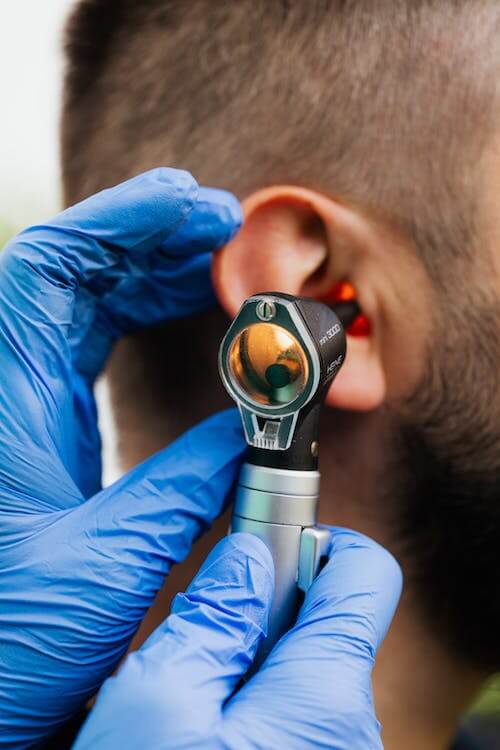Key Takeaways:
- Lumps are usually benign. In rare cases, they can indicate cancer.
- A physician can determine whether a lump behind the ear is cause for concern and provide a plan for treatment.
Finding a lump anywhere can be concerning, but oftentimes, the cause is unrelated to cancer. A lump behind the ear could simply be a swollen lymph node caused by an infection, common cold, or a skin condition.
In some uncommon cases, the lump can be a tumor, and may either be benign or cancerous.
There are various ways to narrow down the cause of a lump behind the ear, but ultimately a physician can determine whether a lump behind the ear is cause for concern.
Possible benign causes of a lump behind the ear
A lump behind the ear is usually caused by an infection or skin condition. For example, if you contract strep throat or an ear infection, the lymph nodes behind your ears can become swollen and inflamed as the body’s lymph node system works to fight off the infection.
Other common infections that can cause lymph nodes behind the ear — or elsewhere — to swell include:
- Impacted teeth: when the tooth remains stuck in gum tissue or jawbone
- Gum disease or infections: gingivitis, and its more severe form, periodontitis
- Influenza
- Lyme disease: a tick-borne virus
- Mononucleosis: a highly transmissible virus commonly known as mono
- Oral herpes or other sexually transmitted infection
- Tonsillitis
Skin infections can also lead to growths called abscesses. These often look like large pimples and are also benign.
More rare, serious infections can also cause a lump behind the ear. Mastoiditis, for example, is a bacterial infection of the mastoid bone behind the ear. This condition usually results from an untreated middle ear infection and symptoms include ear drainage and severe pain. It is more often seen in young children but can occur at any age.
There are other benign causes of growths in this region, including:
- Keloids: lumps caused by scarring, usually from piercings. Keloids are rare and difficult to treat since they often return after surgery.
- Lipomas: a type of benign, fatty growth that is soft and can be moved under the skin. Treatment generally isn’t necessary.
- Cysts: soft lumps made up of dead skin cells and oils. Usually benign, they can sometimes become unsightly and uncomfortable. There is also a risk that they become infected.
Can an ear lump be cancer?
Some cancers will result in a lump behind the ear including parotid (or salivary gland) cancers, although tumors behind the ear are uncommon.

What does a cancerous ear lump feel like?
Cancerous tumors usually share a few key characteristics. They are often:
- Fixed in place
- Uneven or irregularly shaped
- Hard to the touch
When to see a physician
A physician can confirm the cause of a lump. If the bump appears out of nowhere, is accompanied by other symptoms such as pain, discomfort, does not go away for several weeks, or feels like it may be cancerous (fixed, hard, and irregular), it is best to see a doctor. Swollen lymph nodes that feel hard, get bigger, or are accompanied by fever, night sweats, or weight loss should also be evaluated by a doctor.
A doctor will perform an examination and ask questions to narrow down the cause of the growth. They may decide that it’s necessary to perform further tests to rule out some causes.
For example, they may ask you to complete a blood test, biopsy, ultrasound, or computed tomography (CT) scan.
Your primary care physician may also refer you to an ear, nose, and throat doctor, or otolaryngologist, who specializes in this area of the body and may be able to do a more comprehensive examination.
What is the treatment for an ear lump?
Your physician will recommend treatments based on the cause of your lump. Many infections that could cause a lump behind the ear will resolve without treatment. Some bacterial infections require antibiotic treatment. To manage any pain associated with an infection, a doctor may recommend you take over-the-counter pain medication.
If the lump is identified as a lipoma or cyst, your physician may recommend removal based on your symptoms.
Tumors, whether benign or malignant, should be evaluated by an ear, nose, and throat doctor. If a lump is malignant, you may need to see an oncologist. Dana-Farber’s physicians in the Head and Neck Cancer Treatment Center work with patients to create treatment plans tailored to their type of cancer to achieve the best possible outcome.
About the Medical Reviewer

Dr. Sehgal completed his fellowship training in hematology and medical oncology at Beth Israel Deaconess Medical Center, a Harvard Medical School teaching hospital, in 2020. Prior to this, he earned his medical degree from the All India Institute of Medical Sciences, New Delhi, and finished residency training in internal medicine at Yale-New Haven Hospital, CT. Dr. Sehgal's research interests are in the fields of translational immuno-oncology and experimental therapeutics. He has previously trained in the Dhodapkar Laboratory at Yale University and Barbie Laboratory at Dana-Farber Cancer Institute. His research has led to publications in scientific journals such as Science Translational Medicine, Nature Medicine, Blood and Journal of Immunology. He is currently engaged in clinical and translational research directed towards delineating mechanisms of therapeutic resistance to immune checkpoint inhibitors and developing more effective combinations with molecularly targeted therapies.

I had a lump behind my ear, was misdiagnosed dr saying it was a sebaceous cyst a lump that has a cottage cheese like substance bath cyst it will go away,by March 5 months later I went to my regular dr he felt lump said it’s parotid tumor, 86% are benign, mine wasn’t tumor was wrapped around my facial nerve tumor and facial nerve removed 7 weeks radiation and Thank God I’m ok it was acinic cell cancer tumor removed at Long Island Jewish Medical Center & Radiation at Memorial Sloan Kettering